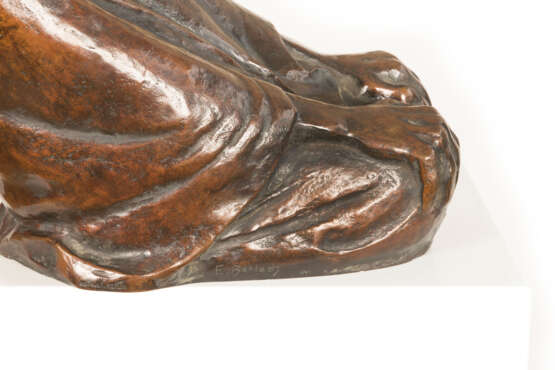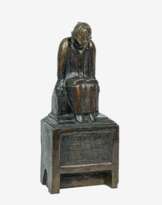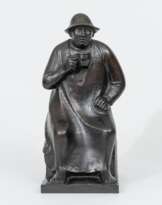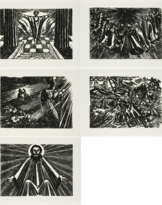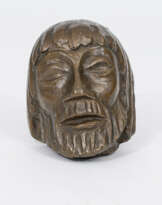ID 1066831
Lot 34 | Ernst Barlach (1870 Wedel - 1938 Rostock)
Estimate value
€ 7 000 – 12 000
Ernst Barlach (1870 Wedel - 1938 Rostock)
'Lachende Alte', Entstehungszeit des Modells um 1936/37, Bronze, goldbraun patiniert, 21 cm x 31 cm x 12 cm, im Guss signiert, Gießerstempel 'H NOACK BERLIN', Literatur: Wvz. Laur 605, mit Abb. S. 267/Schult 483, mit Abb. S. 252. Weiterführende Literatur (jeweils anderes Exemplar): Isa Lohmann-Siems/Gunhild Roggenbuck: Ernst Barlach Haus, Stiftung Hermann F. Reemtsma, Plastiken, Handzeichnungen und Autographen, Hamburg 1977, Nr. 68. Heinz Spielmann: Stiftung und Sammlung Rolf Horn, 2. Aufl., Schleswig 1995, Nr. 129. Anita Beloubek-Hammer: Ernst Barlach, Plastische Meisterwerke, Leipzig 1996, S. 18, 154f.
Ernst Barlach fokussierte sich in seinen Plastiken nahezu ausschließlich auf die menschliche Figur. Sein Ziel war es keineswegs ein Ideal zu erschaffen, sondern seinen Figuren einen zutiefst menschlichen Ausdruck zu verleihen und so ein lebendiges Bild des zeitgenössischen Menschen in all seinen Facetten des Alltags zu kreieren. Der Bildhauer erschuf den Menschen nicht neu, sondern formte ihn so, wie er ihn selbst sah und empfand. Vom Jugendstil inspiriert, fand Barlach seine ganz eigene und unverwechselbare Formensprache.
Insbesondere die Russlandreise, die der Künstler 1906 unternahm, hatte eine prägende Wirkung auf sein Leben und Werk.Fröhliche Gesichter sind im Oeuvre Barlachs nur zweimal zu finden: im "Singenden Jüngling" von 1928/30 und in der befreit lachenden Alten, aus den Jahren 1936/37. Die hier angebotene Lachende Alte zeugt von einer offensichtlichen seelischen Erleichterung, die der sonst sehr ernste Künstler zuweilen selbst empfand. Er selbst sagte: "Manchmal scheint eine grundlose Heiterkeit sich aus Himmelhöhen directement herabzulassen auf den Boden der gewohnten Depression zu erweichen, die ihre Trübseligkeit dann von neuem Aufbauen muss, wenn sie es nicht lassen kann." (Friedrich Droß (Hg.): Ernst Barlach, Briefe, München 1968, Bd. II, S. 776).
Schmucklos, ohne viele dekorative Elemente modellierte Barlach eine ältere Dame, die aus vollem Herzen und tiefster Kehle lacht - ein Urgefühl der menschlichen Psyche und doch etwas so Besonderes in den schweren Zeiten der 1930er Jahren. Für einen kurzen Moment scheinen alle Lasten und die allgegenwärtige Schwermütigkeit von der Dame abgefallen zu sein. Die Plastik besticht besonders durch die große Natürlichkeit ihres Ausdrucks, denn die reine Emotion, das Temperament der Alten und ihre expressive Gefühlslage stehen im Vordergrund. Keine überflüssigen Details sollen von diesem kurzen Moment der Unbeschwertheit ablenken. Stattdessen scheint sich die Plastik regelrecht aus dem Lachen der Alten zu formen. Ihr ganzer Körper wiegt sich überschwänglich nach hinten und scheint fast schon zu brechen, während sie mit weit verzerrtem Mund aus vollem Halse lacht.Auch wenn die Lachende Alte dem Spätwerk Barlachs entspringt, ist sie doch elementar für sein Gesamtwerk und veranschaulicht meisterhaft sein Können, wenn es um die Umsetzung menschlicher Emotionalität geht.
Ernst Barlach (1870 Wedel - 1938 Rostock)
'Laughing Old Woman', date of origin of the model c. 1936/37, bronze, golden brown patina, 21 cm x 31 cm x 12 cm, signed in the casting, foundry stamp 'H NOACK BERLIN', literature: Cat. rais. Laur 605, with ill. p. 267/Schult 483, with ill. p. 252. Further literature (different specimen in each case): Isa Lohmann-Siems/Gunhild Roggenbuck: Ernst Barlach Haus, Stiftung Hermann F. Reemtsma, Plastiken, Handzeichnungen und Autographen, Hamburg 1977, no. 68. Heinz Spielmann: Stiftung und Sammlung Rolf Horn, 2nd ed., Schleswig 1995, no. 129. Anita Beloubek-Hammer: Ernst Barlach, Plastische Meisterwerke, Leipzig 1996, pp. 18, 154f.
Ernst Barlach focused almost exclusively on the human figure in his sculptures. His aim was by no means to create an ideal, but to give his figures a deeply human expression and thus create a vivid image of contemporary man in all his facets of everyday life. The sculptor did not recreate man, but shaped him as he himself saw and felt him. Inspired by Art Nouveau, Barlach found his very own and unmistakable formal language. In particular, the trip to Russia that the artist undertook in 1906 had a formative effect on his life and work.Happy faces can only be found twice in Barlach's oeuvre: in the Singing Youth from 1928/30 and in the liberated Laughing Old Woman, from 1936/37. The Laughing Old Woman offered here testifies to an obvious spiritual relief that the otherwise very serious artist himself sometimes felt. He himself said: ''Sometimes a causeless cheerfulness seems to descend directement from the heights of heaven to soften the ground of habitual depression, which then has to build up its gloom anew when it cannot let it go''. (Friedrich Droß (ed.): Ernst Barlach, Briefe, Munich 1968, vol. II, p. 776). Unadorned, without many decorative elements, Barlach modelled an elderly lady laughing from the bottom of her heart and throat - a primal feeling of the human psyche and yet something so special in the difficult times of the 1930s. For a brief moment, all the burdens and the omnipresent melancholy seem to have fallen away from the lady. The sculpture is particularly captivating because of the great naturalness of its expression, for the pure emotion, the temperament of the old woman and her expressive emotional state are in the foreground. No superfluous details are meant to distract from this brief moment of light-heartedness. Instead, the sculpture seems to literally form itself out of the old woman's laughter. Her whole body sways exuberantly backwards and almost seems to break as she laughs at the top of her lungs with her mouth wide open. Even though the Laughing Old Woman originates from Barlach's late work, it is elementary to his oeuvre as a whole and masterfully illustrates his skill when it comes to translating human emotionality.
| Artist: | Ernst Barlach (1870 - 1938) |
|---|---|
| Auction house category: | Figures and sculptures |
| Artist: | Ernst Barlach (1870 - 1938) |
|---|---|
| Auction house category: | Figures and sculptures |
| Address of auction |
WETTMANN | Auktionshaus an der Ruhr Friedrichstraße 67-67a 45468 Mülheim an der Ruhr Germany | ||||||||||||||
|---|---|---|---|---|---|---|---|---|---|---|---|---|---|---|---|
| Preview |
| ||||||||||||||
| Phone | +49 (0)208 3059081 | ||||||||||||||
| Fax | +49 (0)208 4391735 | ||||||||||||||
| Buyer Premium | 30% | ||||||||||||||
| Conditions of purchase | Conditions of purchase | ||||||||||||||
| Business hours | Business hours
|





